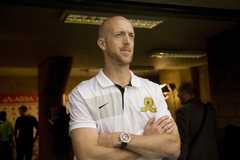Football World Cup / South Africa
Rainbow warrior
In the first of a series on World Cup players, nations and managers, Monocle looks at South African Matthew Booth. He’s an unlikely poster boy for the tournament but his tough tackling and marriage to a top black fashion designer mean he has the popularity and power to unite the nation.

When visitors watch South Africa’s national football team play for the first time there is an uncomfortable moment when the ball approaches the only white man in the side. Boos ring out across the stadium. This doesn’t appear to be the post-apartheid rainbow nation the television adverts promote. Or is it? The overwhelmingly black crowd may sound like they are jeering, but they are actually cheering. The word they yell is “Booth”, strung out for several seconds, celebrating the man who has become the unlikely face of South Africa’s World Cup dream.
The image of Matthew Booth, a tall, uncompromising defender with a broken nose and shaved head, is becoming ubiquitous across South Africa, whether he is staring down from billboards advertising mobile phone networks or appearing in television charity appeals. Along with his wife, model turned fashion designer Sonia Bonneventia, Booth has become a symbol of the new South Africa as it prepares to host the 2010 World Cup in June and July.
Booth, who attended an all-white school during apartheid, shunned the traditional “white” sports – rugby and cricket – and played football. From the age of five he was playing with black and mixed-race boys. “Colour didn’t matter at that age,” he says. Booth’s and Bonneventia’s backgrounds are “chalk and cheese”, she says. While Booth grew up in a middle-class white area of Cape Town, Bonneventia shared two rooms in Soweto with 16 brothers, sisters and cousins. She began entering local beauty pageants at the age of nine and, by the time she was a teenager, she was winning regularly. “It was my way of escaping the realities of township living,” she says.
The couple met when Bonneventia was babysitting for one of Booth’s team-mates and they now have two boys, Nathan, aged five, and one-year-old Noah. Bonneventia was already a football fan, but in terms of fashion, Booth was “comfortable in my sporting gear”. That’s all changed. The couple regularly go to fashion shows and Booth has become a big supporter of South African designers. “Our fashion industry has improved dramatically over the past couple of years,” he says. “I’ve started buying only local goods.”
Booth and Bonneventia view the World Cup as an opportunity for South Africans to show off to the world, whether it’s on the football pitch, in fashion or business. “We have to make the most of it,” says Bonneventia. Much of the coverage in the media outside South Africa has focused on whether the country will be ready to host the tournament. Every country that hosts a major championship faces criticism in the run-up but Danny Jordaan, the head of the organising committee, argues that the concerns expressed about South Africa are more severe because some people do not believe an African country has the capacity to organise one of the world’s biggest events.
“We want to explode the myth that there is a contradiction between being African and being world class,” he says. “And it is a myth.” For South African football fans, the bigger issue is whether the team will be ready. Known as Bafana Bafana, meaning “the boys the boys” in isiZulu, the national team won the Africa Cup of Nations in 1996. Since then they have got steadily worse. They have lost eight of their last nine matches and failed to qualify for the 2010 Cup of Nations, which will be hosted in Angola in January. No World Cup host has ever failed to reach the second round when the tournament is on their soil. “It is going to be tough,” Booth admits, “but we believe we can match the best in the world.”
Booth, who plays his club football for Mamelodi Sundowns, is popular because he has “crossed the divide”, argues Professor Steven Friedman, a Johannesburg-based political analyst. “White players who play for the national team are idolised by the fans,” he says. It’s not a view Booth shares. “No one should make me out to be special. Our local Premier League has a very good smattering of white players and a fair representation of all races.”
While the national team has been far more representative of the population than its cricket and rugby counterparts, the same cannot be said of the spectators. Football crowds in South Africa tend to be almost entirely black, although during last summer’s Confederations Cup, a World Cup warm-up, organisers were pleased that more of a cross-section of society attended. “There was a substantially higher white attendance,” said Professor Friedman. “That hasn’t happened before.”
So it could be the World Cup has a lasting effect on the sport in South Africa. Making it no longer the poor, black man’s sport but a national one that brings blacks and whites together.
South Africa - Highs and lows
World ranking: 85
Number of times qualified: Two (1998, 2002); they qualify automatically as hosts for 2010.
Highest finish: First round (1998 and 2002).
Average salary of a premier league footballer: €1,300 to €1,600 a month.
Worst football moment: South Africa was banned from international contests until 1992 after the end of apartheid.
Best football moment: South Africa wins the African Nations Cup on its first attempt in 1996.
National football heroes: The political prisoners, including current president Jacob Zuma, who established a football league on Robben Island in 1966.


